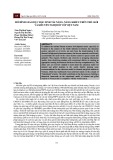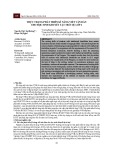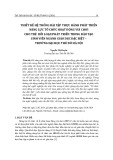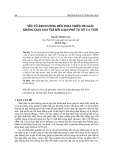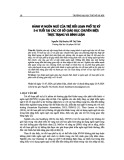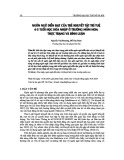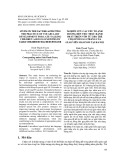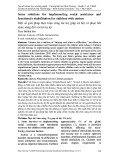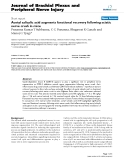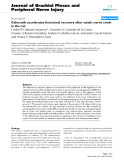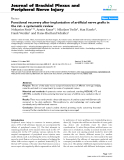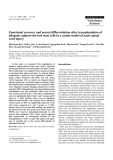
Some solutions for implementing social assistance and
functional rehabilitation for children with autism
Một số giải pháp thực hiện công tác trợ giúp xã hội và phục hồi
chức năng đối với trẻ tự kỷ
Tran Thi Hai Yen
National Academy of Public Administration
E-mail: tranthihaiyen.tm@gmail.com
Abstract: Vietnam has a tradition of "helping each other in difficulties," but efforts to
implement social assistance and functional recovery for children with autism in Vietnam
are still lacking. In implementing social support and rehabilitation for autistic children,
there are some practical barriers, such as the legal framework in the provisions of the Law
on Persons with disabilities 2010 which still has certain gaps in social support and
rehabilitation for autistic children. The Party and State's policies have initially paid
attention to autistic children but there is still a lack of implementation conditions, and there
is still some incomplete awareness of autistic children in general; stigma against persons
with disabilities, discrimination against persons with disabilities, social work still has some
unprofessional points. Internal barriers of autistic children such as the inability to live
independently without a caregiver nearby. This article examines in-depth some solutions
for implementing social assistance and functional recovery for children with autism in
Vietnam today.
Keywords: Autism; Functional recovery; Social assistance.
Tóm tắt: Việt Nam có truyền thống “lá lành đùm lá rách”, “lá rách ít đùm lá rách nhiều”.
Đảng và Nhà nước ta đã thực hiện nhiều chính sách, pháp luật an sinh xã hội bảo đảm cho
quyền lợi của các nhóm dễ bị tổn thương. Trong việc thực hiện trợ giúp xã hội và phục hồi
chức năng cho trẻ tự kỷ còn một số rào cản trên thực tế, như khuôn khổ pháp lý quy định
tại Luật Người khuyết tật 2010 vẫn còn những khoảng trống nhất định trong việc hỗ trợ xã
hội và phục hồi chức năng cho trẻ tự kỷ. Các chính sách của Đảng và Nhà nước bước đầu
đã quan tâm đến trẻ tự kỷ nhưng còn thiếu điều kiện thực hiện và nhận thức về trẻ tự kỷ
nói chung còn chưa đầy đủ; kỳ thị người khuyết tật, phân biệt đối xử với người khuyết tật,
công tác xã hội còn một số điểm chưa chuyên nghiệp. Rào cản bên trong của trẻ tự kỷ như
không có khả năng sống độc lập nếu không có người chăm sóc bên cạnh. Bài viết đi sâu
nghiên cứu một số giải pháp thực hiện trợ giúp xã hội và phục hồi chức năng cho trẻ tự kỷ
ở Việt Nam hiện nay.
Từ khóa: Phục hồi chức năng; Trợ giúp xã hội; Trẻ tự kỷ
1. Some barriers to implementing
social assistance and functional
recovery for children with autism
Firstly, structural barriers
Autism is a neurodevelopmental
disorder characterized by difficulties in
social interaction and communication,
as well as repetitive behaviors. It affects
approximately 1% of the global
population [1]. Autism is prevalent
worldwide, affecting the socio-
economic needs of individuals, families,
and society due to autism spectrum
disorders, developmental disorders, and
related disabilities [2]. Children with
autism display impairments in
Tạp chí khoa học và công nghệ - Trường Đại học Bình Dương – Quyển 7, số 1/2024
Journal of Science and Technology – Binh Duong University – Vol.7, No.1/2024
113
https://doi.org./10.56097/binhduonguniversityjournalofscienceandtechnology.v7i1.217





